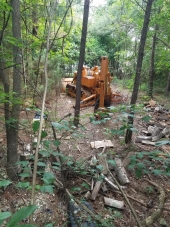Welcome to the forum, M! I'm Q, and 007 is on assignment.
Just kidding. I'm not Q. I just try to emulate him in a permacultural fashion. I have no knowledge of 007's whereabouts.
I have to second both the forestry mulcher/shredder idea, and the goat idea. I think these are your best options. You did mention that you aren't on the land presently, which means that the goats would happen when you move onto the land, or if you have neighbours that have goats that would benefit from grazing on your partially cleared land.
If you have no real soil, I would definitely not remove anything from the property. I would go with the forestry mulcher/shredder first if you can find one to rent, as it's not necessarily the type of thing you'd be doing more than once in a while, if ever again after. The mulch from that will give you something to seed into, and something to not only retain water but to also feed your soil life, from soil bacteria to fungi and all the macrobiota that eat them and make soil.
Speaking of soil life, I would suggest in the strongest terms that you look into actively aerated
compost extracts and fungal slurries. It sounds labourious, but honestly, it's like adding a kick of nitrogen to a largely carbon-dominant compost; suddenly, all the soil life explodes. You'd be brewing up the correct soil microbiota to add to your mulched slash, which they would begin to decompose, thriving as they did, and then either native fungi would come in and do all the good mycelial things, or you could add a fungal slurry of desired culinary or medicinal mushrooms.
The clay in your soil suggests that you need all that organic matter to decompose in place. I recommend a soil test to see where you stand. Especially if deficient in calcium, I would get some gypsum grit of a couple different grades and add that. It will not only solve any calcium issues without affecting the pH, but it will give the fine clay particles something besides themselves to stick to, along with the organic matter, such that the soil structure opens up.
After this, I would suggest identifying the plants that grew up by themselves, specifically the grasses and whatever you think might coexist with the green manures and supportive guilds that will build your soil. I would get something like alfalfa in there, or else some other pastoral plant that drops deep root zones and/or likes to open up soils. Dandelions might work a treat if you have them locally, and mangelwurtzel beets and daikon or tillage radishes would drop serious organic matter down through the subsoil, to rot there and deepen your soil even if nothing but soil life touches it. Usually people like to add clovers and cowpeas, too, plants that can host bacteria that fix atmospheric nitrogen, making it bioavailable for plant use.
If you don't anticipate being able to have animals for a while, I would suggest you think about seeding with things that will draw wildlife to do the work the goats aren't there to do.
The great thing that mulching everything down will do is it will give you an accurate idea of the terrain features, and what you have to do to repair the hydrology on your property that the loggers may have destroyed. Your creek might have been just a creek, for instance, without the swampy bits, and you might be able to improve that somewhat with some careful earthworks.
I am excited to hear more about your property, M. I strongly suggest, when you have a chance, that you peruse
Dr. Bryant Redhawk's Epic Wiki of Soil Threads. In there you will find everything you need, I'd wager.
In any case, please keep us posted, with pics, if you're so inclined, and good luck.
-CK
A human being should be able to change a diaper, plan an invasion, butcher a hog, conn a ship, design a building, write a sonnet, balance accounts, build a wall, set a bone, comfort the dying, take orders, give orders, cooperate, act alone, solve equations, analyze a new problem, pitch manure, program a computer, cook a tasty meal, fight efficiently, die gallantly. Specialization is for insects.
-Robert A. Heinlein

 2
2




 5
5





 5
5




 7
7




 6
6




 5
5




 6
6




 2
2








 3
3




 2
2




 1
1




 3
3




 2
2











